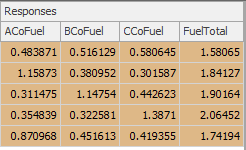
cwitte
-
Posts
12 -
Joined
-
Last visited
Content Type
Profiles
Forums
Events
Gallery
Downloads
Posts posted by cwitte
-
-
refueling_Routing2withaddin.spfxHere is my model. I'm specifically dealing with ModelwithFailure and looking at Experiment2.
-
That is what I thought. However, my results are not making any sense. I see the following:


Logically, adding 5 hours of travel time via an interdiction should lower the responses (at the very least the FuelTotal) however, this is not the case. Just as a quick test I changed the interdictions to negatives and received more logical results. However, when I view individual runs of each of these cases, the opposite of these results is what I receive: Fuel levels plummet and reach 0 multiple times during the scenario since the transports can't keep up (w/ 5hr interdiction) or the transports 'teleport' to the ACo node since there is a -5hr interdiction and therefore the transports are always able to keep the servers at high fuel levels.
I must be missing something here.
-
I am running some experiments on my model. I have a couple of transporters delivering fuel to three server nodes. I am trying to have the model maintain adequate fuel levels at the servers despite disruptions. Currently I have 4 responses (1 for each server and 1 that sums their fuel levels) and the responses are based on the expressions:
Input@LineCompany1.AssociatedStationLoad
Input@LineCompany2.AssociatedStationLoad
Input@LineCompany3.AssociatedStationLoad
and FuelTotal: Input@LineCompany1.AssociatedStationLoad + Input@LineCompany2.AssociatedStationLoad + Input@LineCompany3.AssociatedStationLoad
I get responses as such:

with the ACoFuel, BCoFuel, and CCoFuel ranging between 0 and 2 and FuelTotal ranging from 0 to 3. The capacities of these server nodes are 0 to 12 and everything is handled in integers. I am confused on how these responses are being calculated and any light that could be shed on this would be greatly appreciated.
-
Is there anyway to do this with the Academic version of Simio? It seems that your method is restricted to the Professional and RPS (Enterprise) versions only.

-
Thanks!
-
I have two transporters that have failure rates and associated downtimes. I am trying to create an output so that I can track the transport downtime (say Truck1[1] failed from Hour X to Hour Y) so that I can analyze the impacts of vehicle downtimes on the system. I don't know the best way to go about doing this: Add-on Process for Failure and for Repair but then Assigning what value to what State/Property/Table? This is where I am getting lost. Any help would be greatly appreciated.
-
My simulation is looking at maintaining inventory levels at multiple servers across a road network. Inventory is delivered via transports and is processed at each station at a rate of 1 item per hour (constant). What I am trying to do is to run some experiments to determine effects of different parameters on delivery system performance (ability to maintain inventory at (between 0-12) at each server location for the duration (72 hours is the current short test case). I have my responses set up to report Input@Server1.AssociatedStationLoad however the numbers are being listed between 0 and 1 instead of 0 and 12. Additionally, in the experiment output I get a 1 or 0 per server per scenario iteration.
What I need to see is if any (and what) server hits 0 at any given time by having an output give an inventory level at current time for the duration of each run.
Any advice?
-
Thank you so much!
-
I have 2 transports delivering entities to 3 servers. What should be happening is that Transport 1 loads entities to capacity (12) then moves to Server 1 and delivers all of the entities (12). Transport 2 should load 12 entities and deliver all 12 to Server 2. Transport 1 returns to Home Node and loads 12 more entities for delivery to Server 3... and so on.
However, what is happening is that both Transports are loading 12 entities then moving to Server 1 and delivering 4 entities each, then on to Server 2 and repeat and so on. I have removed and added servers to confirm that for some reason the Transports are delivering 1/#ofServers of their total capacity, conducting all of their deliveries and then returning to home once empty. I have limited the timepath to each Server to only allow 1 Transport at a time, but then Transport 2 just waits at the Home Node until Transport 1 is on its way to Server 2. Then it moves to Server 1 and just ends up one node behind Transport 1 at all times.
The dispatch logic: (Server1.InputBuffer.Contents.NumberWaiting <= 12)||(Server2.InputBuffer.Contents.NumberWaiting <= 12)||(Server3.InputBuffer.Contents.NumberWaiting <= 12); set at Smallest Value for Selection Goal; Selects from a List of all Server Nodes.

Response Calculations
in SI General Discussions
Posted
Trying to upload again after another save. Let me know if this works. I'm using the full Student edition. I'd have to look up the exact version, but it should be the latest.
refueling_Routing2withaddin.spfx